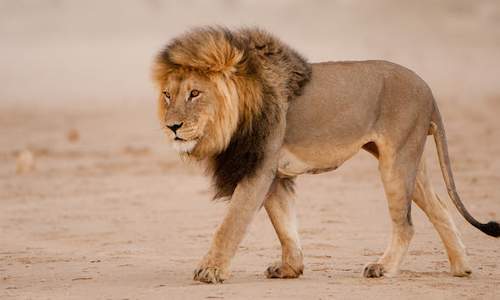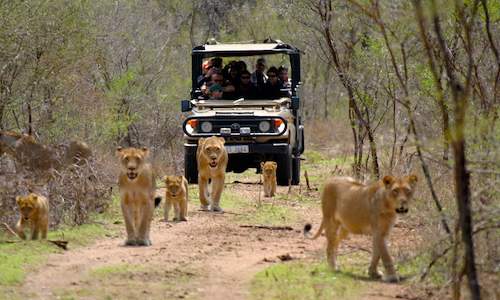Images of a Great African Park
The Big Five
What are the Big 5 in Africa?
The Big 5 wildlife refers to the Lion, Leopard, Rhino, Elephant and Buffalo. These are often the most in-demand animals to see while on an African safari.
By 1896 white rhino were extinct in the Lowveld, while elsewhere a relic 50 animals survived between the White and Black Umfolozi rivers in Zululand. Successful conservation measures made it possible to re-introduce 337 rhino from 1961 onwards, and the Kruger Park now safeguards the world's largest population.
White rhino require a reliable supply of water, both for drinking (every two to three days). In Kruger National Park, 85 per cent of the white rhino population occurs in the Southern Region, where rainfall is higher than average and water holes are evenly distributed. Their senses of smell and hearing are good, but their eyesight is poor.
A
white rhino bull marks his territory by spray-urinating along its boundaries. Only territorial males do this; subordinate males are allowed to live within the territory so long as they remain submissive. Females are free to wander across the territories of several males.
White rhino coat their hides in mud to reduce bites from irritating flies, and during the hot summer months mud wallows help to regulate body temperature.
With a considerable body mass of up to 2 300 kilograms, and a vast surface area that is increased by folds of skin, white rhino can remove large quantities of mud from a wallow with each visit. Over the decades this has the effect of excavating significant depressions in the veld, which are rapidly filled during the rainy season to form pans.
An
elephant drinks from a pool in the Mphongolo River that still holds water during winter months. An elephant can draw 17 litres of water at a time. During winter, elephant are usually concentrated within six kilometres of water and drink on average every two days, consuming between 180 and 400 litres per visit.
Two
young elephants play on the soft, cool sandy bed of the Mphongolo River. Elephants live in well-ordered family groups that are usually led by the oldest female, the matriarch. In addition to the matriarch, the group consists of her older female calves, related females and their offspring. Males leave the herd from the age of 12 years.
The elephant with its dexterous trunk, which is composed of 50 000 muscles, is able to carefully select leaves from among the thorny branches of a
thicket of Delagoa thorns (Acacia delagoensis).
Young buffalo depend on the structure of the herd for protection. Buffalo are almost exclusively grazers, and half the Kruger population occurs on the open savannas of the Central Region.
These bovids consume large quantities of grass of a moderate quality, and in doing so play a valuable role in the ecosystem by reducing tall grasslands and opening up areas for the antelope that feed only on short grasses.
As an
adult can weigh more than 750 kilograms, buffalo comprise a quarter of Kruger's total biomass, or live weight of animals. Although lion working together can overpower an adult bull, the availability of sufficient grass is the most important limiting factor on herd size.
Unlike most antelope species, male buffalo voluntarily leave the breeding herd and rejoin at a later stage. A herd does not occupy a fixed territory, and its favoured home range includes certain areas that are utilised during winter, and an expanded range that is used during summer.
Typically, old bulls eventually become permanently separated from the herd to live a solitary existence, or form small bachelor groups.
In winter,
buffalo in Kruger National Park concentrate within eight kilometres of permanent water, especially along the Sabie, Olifants, Letaba and Shingwedzi rivers, and the sight of a herd of several hundred buffalo raising clouds of red dust as they trek to water is one of the most memorable that the Park can offer.
A dominant buffalo bull asserts his position by holding his head high while pointing his nose towards the ground.
Head-tossing and a hooking motion of the horns are also used. If this fails, the bull will batter his solid horn boss against that of his rival until he gives in.
Under favourable conditions, when game concentrates around water holes and there is a steady supply of prey,
a lioness can give birth to a litter of one to five cubs every two years. Within a pride most cubs are born at the same time, mostly between February and April when young prey animals are abundant.
Since the establishment of the Park in 1898, lion have increased proportionately to a significant increase in their prey species. In the 1920s Stevenson-Hamilton counted 600 lion in the Park. Today, Kruger supports about 2 000, representing one of the largest populations in Africa.
The
mane of a dominant pride lion protects the head and neck from injury and deters rival males by making the lion appear more formidable. In East Africa the Maasai people have copied this mask, and warriors wear feathered headdresses to appear taller and more menacing.
Lion keep a close watch on descending vultures in the hope of
locating a potential meal. Lion are opportunistic predators that will also scavenge food from other predators, and in this instance were able to locate the vultures and the remains of a kill in less than 20 minutes.
Although lion spend much of the day resting, a charging lion dispels any doubts about their strength, speed and agility.
Most chases are short and do not exceed 200 metres, but a lion can attain a speed of 60 kilometres an hour in a final burst of speed before bringing down prey.
Play activities within the safety of the pride prepare lion cubs for
hunting success in adulthood. Young cubs display a pattern of brown spots and rosettes that is similar to the patterning on the coat of leopard, and may be useful as camouflage.
A
large male leopard can weigh as much as 70 kilograms, but females are much lighter at about 30 kilograms. Impala comprise 78 per cent of the leopard's diet in Kruger. An adult leopard requires prey equivalent to about 20 impala per year, so leopard predation is not a major limiting factor on impala numbers.
As
leopard are primarily nocturnal and active when lion and hyaena are about, these powerful cats have to face strong competition. In the Kruger Park they prey mainly on impala and aggressively defend their kills against rival predators. Essentially ground dwelling, leopard readily climb trees to escape from danger and to store their kills safely out of the reach of other predators.
Long believed to be very scarce, in the 1970s an American researcher captured a surprising number of leopard within a few kilometres of Skukuza, and the estimate of the total number in the Park was revised to about 1 000. The number is believed to have remained relatively unchanged up to the present. This is because - barring major habitat changes and human interference -
leopard populations tend to remain stable, kept in balance by the availability of prey species and the corresponding size of each leopard's territory.
While leopard inhabit all 16 of Kruger's major vegetation types,
the highest densities occur in dense riverine bush bordering rivers such as the Sabie and Shingwedzi.
By Nigel Dennis & Michael Brett.
The ultimate treasures of the South African bushveld are undoubtedly the Big Five Wildlife in Kruger National Park. These iconic animals are...
more
These Kruger Park classic lodge safari holiday packages focus on Big Five game viewing, guided game drives and an authentic safari lodge exp...
more


















 The ultimate treasures of the South African bushveld are undoubtedly the Big Five Wildlife in Kruger National Park. These iconic animals are...
The ultimate treasures of the South African bushveld are undoubtedly the Big Five Wildlife in Kruger National Park. These iconic animals are... These Kruger Park classic lodge safari holiday packages focus on Big Five game viewing, guided game drives and an authentic safari lodge exp...
These Kruger Park classic lodge safari holiday packages focus on Big Five game viewing, guided game drives and an authentic safari lodge exp...